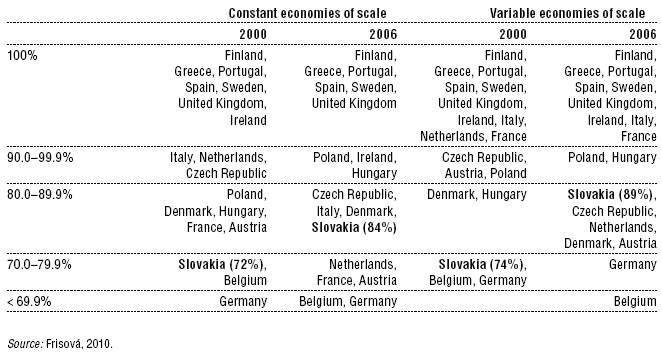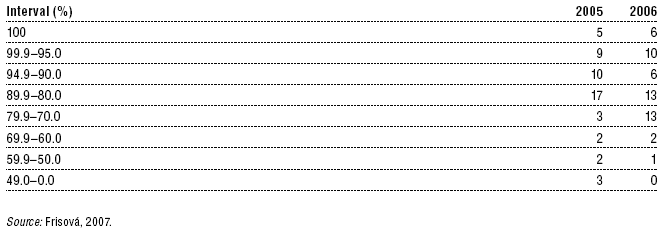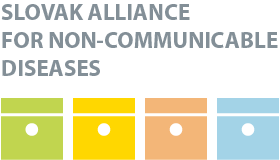—
HPI Network > HPI - Health Policy Institute > Health System in Slovakia > 7. Assessment of the health system > 7.4 Technical efficiency
7.4 Technical efficiency
Friday, 06. May 2011, 20:31 — HPI
| << PREVIOUS
7.3 Efficiency of resource allocation |
Introduction – Organization – Financing – Resources – Provision – Reforms – Assessment – Conclusions – Appendices |
NEXT >>
7.5 Contribution of the health system to health improvement |
Increasing technical efficiency is important in an environment with limited financial resources. According to Osterkamp (2004), out of every €1 invested, only €0.62 was used effectively in Slovakia in 2000. The low technical efficiency of Slovakia in the year 2000 (72%) was also confirmed by Frisová (2010) through a Data Envelopment Analysis based on OECD Health Data (OECD, 2009). According to this analysis, Slovakia increased its technical efficiency substantially between 2000 and 2006 (Table 7.6). Slovakia was able to decrease its inputs (mainly by reducing the number of nurses and beds; while the number of doctors remained stable) and increased its outputs (improved life expectancy at birth and lower infant mortality). The technical efficiency increased from 72% to 84% (when measuring constant economies of scale) and improved from 74% to 89% (when measuring variable economies of scale).
Table 7.6: Rise in technical efficiency of Slovakia between 2000 and 2006

The Slovak health system has historically been characterized by high utilization of health care services. Although the introduction of user fees in 2003 decreased the number of contacts, the visiting rate remained high. After reducing and partly abolishing the user fees in 2006, the number returned to 2002 levels by 2007.
In addition to this, visits to the GP are generally concluded with a drug prescription or a referral to a specialist. This GP behaviour is understandable in light of the current payment method (capitation) – with little effort a high number of patients can be “helped”. This behaviour induces demand for drugs, laboratory examinations, diagnostics and specialists’ time and causes high opportunity costs for the system. There is a great deal of anecdotal evidence about how pharmaceutical companies, laboratories or pharmacists motivate GPs or specialists to prescribe a certain drug or send samples for examination to a given laboratory or recommend a specific pharmacy to patients.
As a heritage from the past, where universality, access and free health care was the main agenda, Slovak people enjoy a dense network of providers, both in outpatient and inpatient care. For more than 70% of people, there is a GP close to where they live. For more than 90%, access to a GP is within 10 minutes travel at standard speed (Szalay, 2008).
Similarly, the network of hospitals is very dense. According to Frisová (2007) there is still room for improving technical effectiveness, that is, 3397 beds, 1784 nurses and 826 physicians could be cut. Compared to 2005 and 2006, the annual technical effectiveness of the monitored hospitals has improved. On the other hand, the technical effectiveness of university hospitals between 2005 and 2006 has slightly declined (Table 7.7).
Table 7.7: Number of hospitals in intervals ranked according to technical efficiency, 2005 and 2006

News
The amendment of the Decree on emergency medical service
Health insurance companies returned over 400 thousand €
The HCSA received 1,647 complaints last year
A half million people will earn more
Most of public limited companies ended in the black
Debt of hospitals on premiums has grown to nearly € 105 MM
Slovak health care may miss € 250 million next year
Profits of HIC amounted to € 69 mil. last year
Owners of Dôvera paid out money but did not paid taxes
Like us on Facebook!
Our analyses
- 10 Years of Health Care Reform
- New University Hospital in Bratislava
- Understanding informal patient payments in Kosovo’s healthcare system
- Analysis of waiting times 2013
- Health Policy Basic Frameworks 2014-2016
- Analysis of informal payments in the health sector in Slovakia
- Serbia: Brief health system review
developed by enscope, s.r.o.
